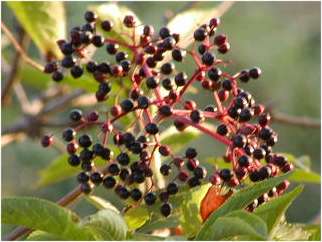Relatives
Sambucus nigra L. - Elder black.
Taxonomic position.
Family Sambucaceae Batsch ex Borkh. Genus Sambucus L.Morphology and biology.
A perennial plant, a bush or a small tree, 4-5 (10) m in height. A trunk up to 30 sm thickness with dehiscent bright - brown bark. Branches with longitudinal wrinkles and surface lenticels acting above. A marrow is wide, white. Leaves up to 30 sm in length, on leaf-stalk, with early falling narrow stipules. Leaflets usually 5-7, have ovate-elliptic or oblong forms, with cuspidate top. Leaflets with serrate edge and pubescent venues on their both sides. Flowers are fragrant, collected into top umbrellate panicles 10-20 sm in diameter, on long peduncle, with 5 main branchy axes. Calyx denticles are ovate, a nimbus is white, 5-8 mm in diameter. Stamens are with yellow anthers. Fruits are spherical, 5-8 mm in length, brilliant, violet - black, with dark red juice, with 3-4 brown, ovate, cross-section wrinkled stones. Enthomophyl. Zoochore. Blossoms in June - July, ripens in August - September.Distribution.
The common distribution: Scandinavia (the south of Sweden), average and the Atlantic Europe, the Mediterranean (including Northern Africa), region Balkany-Asia Minor. In territory of the former USSR: the European part - Baltic, the Top and Average Dnepr, the Volga Don region, the Top Dnestr, Bessarabia, Black Sea Coast, Crimea, the Bottom Don; Caucasus - Ciscaucasia, Dagestan, Western and East Transcaucasia..Ecology. In woods and on marges, in thrickets of bushes, it is especial - on the rivers, lengthways roads, on weed places. In mountains it reaches an average mountain belt. It is frequently cultivated and easily runs to be wild.
Use and economic value. Medicinal (are used flowers, fruits, a bark, leaves and roots). Flowers are most widely used in the medical purposes - at cold. Flowers also are used in winemaking for giving fault, and also - to cognacs and liquors, a smell of a muscat. In the confectionery purposes Flowers are used for giving to a batch of taste of bitter almonds. Fruits possess laxative properties, and also are used as seasoning to food and for manufacturing fruit candy. Leaves are poisonous. Wood does not decay and consequently is frequently used for piles, support and for manufacturing musical instruments. Decorative: there are forms with dissected leaves, with motley leaves; with pyramidal, spherical and weeping form of a crone; with yellow, light green and transparent fruits.
References:
Cherepanov, S.K. 1995. Plantae Vasculares Rossicae et Civitatum Collimitanearum (in limicis USSR olim). St-Petersburg, "Mir I Semia", 990 p. (in Russian).Gubanov, I.A., Kiseleva, K.V., Novikov, V.S., Tikhomirov, V.N. 2003. Vol. 2. Illustrat a determinant of plants of Average Russia. Moscow . 665 p.
Galushko, A.I. 1978. Flora of Northern Caucasus. Vol. 3.House of the Rostov university,
p. 120
Flora USSR, 1958. Vol. 23. B.K. Shishkin (ed.) M.-L.: Publishing House of Acad. Science, pp. 424-426. (in Russian).
Tsvelev, N.N. 2000. ManuaL of the vascular plants of North-West Russia (Leningrad, Pskov and Novgorod district). St.Petersburg, Publishing House of SPHFA, p. 511. (in Russian).


